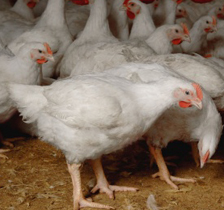Finding suitable alternatives to antibiotics in broiler production

The emergence of antibiotic-resistant pathogens in humans is driving efforts to find commercially viable substitutes for antibiotics frequently used in the production of food animals, including poultry.
While much progress has been made, much work remains, according to a recent article in Poultry Science, a journal published by the Poultry Science Association (PSA).
The article, “Historic Perspective: Prebiotics, Probiotics, and other Alternatives to Antibiotics”, also helps explain key differences between and among the often confusing variety of alternatives currently being examined. The paper was originally presented by its author, Dr. Michael Hume, a researcher at the United States Department of Agriculture, Agricultural Research Service, in College Station, Texas, at a PSA symposium on the potential impact of reduced antibiotic use and the roles of alternatives to antibiotics in antibiotic-free broiler production.
“Calls for restricting the use of human health-related antibiotics in food animal production are now receiving more attention than ever from the scientific community, food animal producers, consumers and the human healthcare community. However, most of these alternative products are still in the experimental stage and are a long way from commercial availability. But the hard work it will take to get there is essential if we want to help protect the vulnerable inventory of human disease-fighting antimicrobials currently in use,” said Dr. Hume.
Probiotics and Prebiotics
Probiotics are living microorganisms, such as the lactic acid bacteria found in yogurt, that provide a health benefit to their host when administered in adequate amounts. They have been embraced by the poultry industry for their utility in pathogen prevention strategies. According to the article, probiotics are viewed as production enhancers that act in the host in a variety of methods to influence “the digestive microflora positively to promote performance and to protect against colonization by harmful bacteria and enteropathogens of human importance.”
To date, probiotics have seen the most growth among the alternatives to antibiotics being studied in terms of translating into commercial products.
Unlike probiotics, prebiotics are not living organisms. They are nondigestible feed ingredients, such as oligosaccharides, which have selective effects on microbiota in the intestines that, ultimately, help improve the health of the host. Prebiotics have also seen commercial growth in the form of, for example, mannan oligosaccharide (MOS) and fructo-oligosaccharide (FOS) products. Mannan oligosaccharides are derivatives of yeast cell walls, while fructo-oligosaccharides can be extracted from fruits, vegetables, and grains.
Bacteriophages
Discovered in 1910, bacteriophages are viruses that attack bacteria, including pathogenic bacteria, directly via infection. They are readily found in most environments colonized by bacteria. According to Dr. Hume, early research interest in bacteriophages faded following the advent of penicillin and other antibiotics. However, there has been a surge of new interest in bacteriophage since the 1980s, when experiments with mice suggested that phage therapy was more effective than treatment with antibiotics such as streptomycin, tetracycline, ampicillin, and trimethoprim/sulfafurazole.
In terms of applications to poultry, bacteriophages are, according to Dr. Hume, thought likely to be unsuitable for use in poultry grow-out facilities because fecal shedding would likely lead to resistance. Instead, bacteriophage therapy would likely be more effective in poultry processing plants because their application to the carcass would be a one-time event. Poultry and farm animal applications of bacteriophages have already been developed for Salmonella, Campylobacter, and Clostridium perfringens, said Dr. Hume.
Other alternatives
The article also discusses several other potential substitutes for antibiotics, including bacteriocins (bacteria-killing proteins first discovered in 1925) and phytotherapeutics (plants, plant extracts, and essential oil distillates). A number of the latter (e.g. ginger, garlic, sage, thyme) are known to express antibacterial properties.
A copy of Dr. Hume’s article is available at ps.fass.org/content/90/11/2663.full.pdf+html. (Subscription required.)













